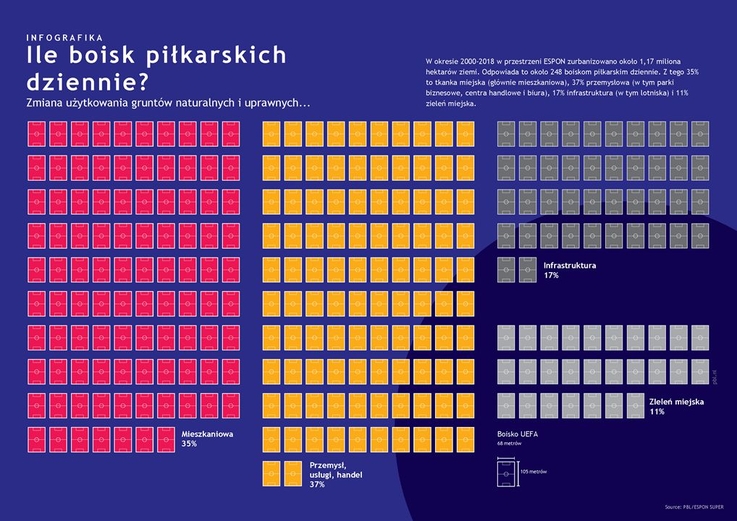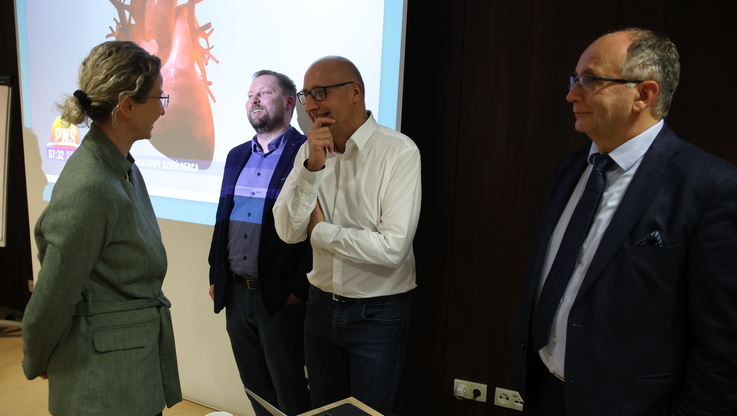Pobierz materiał i Publikuj za darmo

Katarzyna Wojnar, PhD, Dorota Celińska-Janowicz, PhD, Adam Płoszaj, PhD, and Magda Grabowska from the EUROREG Centre for European Regional and Local Studies of the University of Warsaw, along with other experts from seven European countries, analysed the urbanisation processes in Europe over the last two decades. Their conclusions and recommendations were published on the website of ESPON, a European observation network financed by the European Commission.
The most surprising observation from the study is not the constantly progressing urbanisation of the continent, but the extremely rapid pace of this process. In the period between 2000 and 2018 as much as 1.25 million hectares of natural, green and agricultural areas were transformed into built-up areas. 37 percent of this area is covered by industrial and service infrastructure (business parks, shopping centres, offices), 35 percent is residential area, 17 percent – transport area, 11 percent – city green areas.
“Our country is in the process of intensive development in terms of building up, in relation to both where we started (making up for the backlog of the Polish People’s Republic) and when compared to other EU Member States. In the analysed period of 2000-2018 Poland was the third country in all of the EU in terms of the intensity of the urbanisation process. In some areas, especially around the biggest Polish cities, this process reached a pace of over 20 thousand square metres per day,” explains Katarzyna Wojnar, long-standing coordinator of the ESPON National Contact Point.
The expert emphasises that Poland differs from almost all other European countries in that its increase in urbanised areas exceeds its population growth rate. In the Mazowieckie, Pomorskie, Wielkopolskie and Małopolskie Provinces, these processes are happening against the backdrop of a growing population (especially around larger metropolises), but in most other areas of this country, the increase in urbanised areas is occurring despite a decreasing population. As pointed out in ESPON’s report, area is a limited resource and its development is, as a rule, long-lasting, so for areas with a decreasing population it would be advisable not only to reduce the pace of creating new urbanised areas, but even to go as far as to renaturalise some already built-up areas.
“To put it bluntly, we are building flats much faster than we actually move in to them and in areas where they shouldn’t be built at all. This is mainly due to the lack of a well-thought out, long-term concept of spatial development in Polish cities that would reflect the demographic transformations,” indicates Katarzyna Wojnar. “For years, many urban planners have been calling to adopt a polycentric urbanisation model that would allow us to avoid the uncontrolled growth of mega-cities, and to do new projects taking into consideration the social interests of their future residents,” she adds.
As the researcher points out, in Sweden about 75 percent of land belongs to the state, and the activities of developers are subject to licensing, with such aspects as the distance of the future buildings from existing schools and kindergartens, cultural institutions, and public transport being taken into account. In addition, a special role is assigned there to the preservation of ecological corridors and access to green areas. Meanwhile, in Poland, everything is decided by the market, which, according to the University of Warsaw expert, takes control over the urbanisation process from the public authorities.
“Eventually, the price will be paid by the residents of new districts, who will have no alternative to car transport and no access to public infrastructure. That's why it’s so important for urban planners, local government authorities and central authorities to sit down and talk about the vision of development of Polish cities and the selection of optimal tools to implement it, as described in ESPON’s study,” said Katarzyna Wojnar.
Source: PAP MediaRoom
Pobierz materiał i Publikuj za darmo
bezpośredni link do materiału
| Data publikacji | 31.12.2021, 11:00 |
| Źródło informacji | PAP MediaRoom |
| Zastrzeżenie | Za materiał opublikowany w serwisie PAP MediaRoom odpowiedzialność ponosi – z zastrzeżeniem postanowień art. 42 ust. 2 ustawy prawo prasowe – jego nadawca, wskazany każdorazowo jako „źródło informacji”. Informacje podpisane źródłem „PAP MediaRoom” są opracowywane przez dziennikarzy PAP we współpracy z firmami lub instytucjami – w ramach umów na obsługę medialną. Wszystkie materiały opublikowane w serwisie PAP MediaRoom mogą być bezpłatnie wykorzystywane przez media. |




